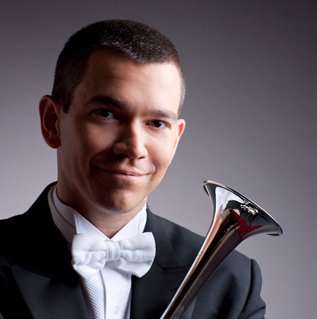|
Back
The Phil Trumpets a New Member New York
David Geffen Hall, Lincoln Center
10/05/2016 -
Béla Bartók: Music for Strings, Percussion, and Celesta, sz. 106
György Ligeti: Mysteries of the Macabre
Ludwig van Beethoven: Symphony No. 5 in C minor, Op. 67
Christopher Martin (trumpet)
New York Philharmonic, Alan Gilbert (conductor)

C. Martin (© Todd Rosenberg)
“The public at large generally believes that a country’s folk music is something homogenous although this is by no means the case.”
Béla Bartók, “Mi a népzene?” (“What is folk music?”), 1931
Béla Bartók and György Ligeti had a lot in common. Both were Hungarian composers born in Romania. Both were severely misunderstood in their creative lives and each had to deal with anxiety and underestimation throughout his whole career. Bartók ended his life as a charity case, dependent on the kindness of strangers. Ligeti died in relative obscurity outside of the academic community and is just now coming into his own. One other trait they share is that each of their endeavors led to magnificent and deeply moving pieces of kinetic art. What would the Ernie Kovacs Show have been without the music of Bartók or the film 2001: A Space Odyssey sans the music of Ligeti? Having the works of these two great men on the same program is as fortuitous as the union between Buda and Pest.
The Music for Strings, Percussion, and Celesta is an amazing puzzle worthy of Lewis Carroll. Not only does the composer set out a very detailed map for platform positioning, but he relies on the proportions of the Fibonacci number sequence to dictate aggregates of notes, measures and durations of beats. With the celestial connection that these numbers exhibit, this perhaps should be the first piece of music sent into deep space for communicative purposes.
I should say right up front that this was the best New York Philharmonic concert that I have attended for a long, long time. Bartók creates a mirror image such that Sheryl Staples, Principal Associate Concertmaster, was sitting in the first chair, leading her ensemble of doppelganger strings from the front of stage left. The two ensembles were sometimes adversarial, sometimes convivial, but always spectacular in creating a sound still, after all of these years, essentially foreign. Maestro Gilbert had his forces comfortably attuned to the complex rhythms of the piece and really seemed to be enjoying himself up there on the podium.
The Philharmonic has a new first trumpet and this was his opportunity to shine. But first, a quick story: Jerome Horwitz was a comedy bandleader in New York in the 1930’s. The very concept is gone from our pop culture, but it was common in those bad old days to have a conductor at the front of a nightclub or dance band who used his position of prominence to make jokes (both vocal and physical) with the instrumentalists. Mr. Horwitz left his position when his brothers called him from Hollywood and he became Curly Howard of the Three Stooges.
What does any of this have to do with Ligeti? Well, last night Alan Gilbert played the role of clown to newcomer Christopher Martin as the two bantered and posed throughout this nine minute piece of musical “pop art” to the delight of an appreciative audience. Mr. Martin does not have a developed stage voice (Mr. Gilbert does) and so his vocal phrases were not intelligible, but perhaps they would not have been even if properly heard. This taste of Ligeti’s opera Le Grand Macabre was both entertaining and a bit disturbing, in other words deeply satisfying.
In the 1930’s (right around the time that Bartók wrote tonight’s piece and Horwitz was joking at the night spots), Pablo Casals hired Anton von Webern to come to Barcelona and conduct a concert whose featured work was the Beethoven 5. Three days of rehearsal were allocated for the event and at the end of the second a reporter asked Webern how things were progressing. The scholarly and diminutive composer answered “Actually quite well. We have the DA-DA-DA-DUH almost where I want it!”
Clearly, Gilbert had all of the preparation time that he needed as he delivered a very taut and exciting reading of that most famous of all of the classics. The first movement was quite fast and remarkably full-bodied, using the preferred tempo of today’s no nonsense maestros. Even the Andante con moto was brisk and to the point. Throughout the assembled forces played at their collective bests and were a pleasure to hear. Mr. Gilbert seems to be saying “won’t you be sorry to see me go?”
Fred Kirshnit
|